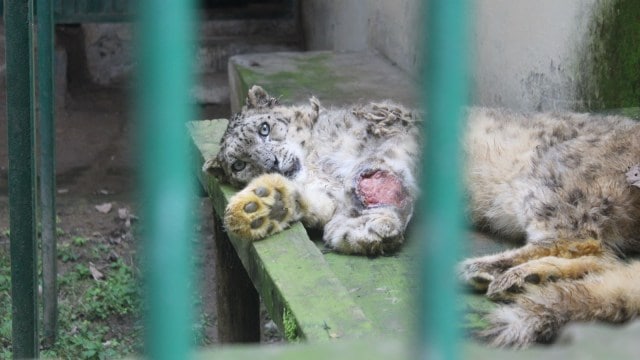Keeping Kajju alive: Shimla zoo faces tough call on snow leopard with cancer
The only snow leopard in captivity in the state, Kajju got its name from the remote village of Kaza in Lahaul & Spiti, from where it was rescued in November 2023.
 Kajju, the only snow leopard in captivity in Himachal, has bone cancer in one of its forelegs. (Express photo by Saurabh Parashar)
Kajju, the only snow leopard in captivity in Himachal, has bone cancer in one of its forelegs. (Express photo by Saurabh Parashar)At the Himalayan Nature Park in Himachal Pradesh’s Kufri hill station, wildlife officials and veterinarians are working overtime to keep Kajju alive.
The only snow leopard in captivity in the state, Kajju got its name from the remote village of Kaza in Lahaul & Spiti, from where it was rescued in November 2023. But osteosarcoma, a malignant form of bone cancer, has meant the animal has spent the majority of its time at the Nature Park under treatment.
According to officials, the animal is currently quarantined in the isolation ward of the veterinary hospital at the nature park, informally called Shimla’s Kufri Zoo. The big cat is receiving palliative care after cancer was detected in its front left leg, which was wounded when it was rescued.
Besides the Kufri Zoo, the only other place where snow leopards, which are a Schedule-1 protected species, are kept is the Padmaja Naidu Himalayan Zoological Park (PNHZP) in Darjeeling.
Visitors had thronged the zoo when word spread that a rescued snow leopard was its newest occupant, hoping to catch a glimpse of the animal, dubbed the ghost of the mountains.
#WATCH | The only snow leopard in captivity in Himachal, Kajju, suffers from osteosarcoma, a malignant form of bone cancer.
Here’s how officials are keeping Kajju alive: https://t.co/8SOwEUPzhz
Video and report by @saurabhprashar2 pic.twitter.com/6msgukdSpG
“Kufri Zoo was known for having snow leopards until 2014. Sibling snow leopards, Subhash and Sapna, were brought to Kufri from Darjeeling under an animal exchange programme in 2004. Sapna died in 2007, and Subhash was sent back to PNHZP in Darjeeling in 2014. In 2019, a proposal was made to bring a pair of snow leopards from Darjeeling, but it never materialised. When Kajju was brought here, hope had emerged that it might stay for a long time and could be put on display after completing formalities. But this discovery has dashed all hopes,” a zookeeper said.
Deputy Conservator of Forest Wildlife, Shahnawaz Ahmed Bhat, said: “Indeed, we recommended the amputation of the affected limb a fortnight ago, but there are many complications. The foremost is Kajju’s age. The snow leopard has already attained the average age of 15 years, making it vulnerable to anaesthesia. We recommended its treatment at Palampur College of Veterinary and Animal Science, where gas anaesthesia facilities are available. Another complication is the malignant nature of the cancer. There are also chances that if the amputation is performed, the animal, due to its old age, will be vulnerable to infection. A committee chaired by the Chief Wildlife Warden will decide whether amputation should be performed or if the animal should continue to be on medication. The animal is in palliative care, receiving medicines to reduce the pain.”
“In Shimla, we can only administer anesthesia through injection, but an animal like Kajju would not be able to recover. At Palampur institute, there is an inhaled anesthesia facility, which allows veterinarians to remove the mask when it is not required,” explained an IFS officer.
A veterinary officer treating the animal told The Indian Express: “The snow leopard was in conflict when it was rescued from a village situated at high altitude in Kaza. It had been stealing mountain goats from the villagers’ sheds, creating panic. At the time of rescue, it was injured, with a deep wound on its left foreleg. We brought it here hoping to release it back into the wild after treatment. But the wound worsened, forcing us to send its samples to the premier Indian Veterinary Research Institute in Bareilly, Uttar Pradesh. We received an inconclusive report in March. We sent fresh samples to Guru Angad Dev Veterinary and Animal Sciences University in Ludhiana, which recently confirmed the osteosarcoma and its malignant nature.”
A visit to the Nature Park suggests that the animal is not able to walk properly, always keeping its wounded leg raised. Forest Ranger Officer, Kufri, Sukh Ram said, “Ever since it was confirmed that the wild animal suffers from osteosarcoma, we have placed it in the isolation ward. The best care is being provided. As its front two canines are also damaged, we are giving it raw meat cut into small pieces.”
In January this year, Wildlife Institute of India concluded that the number of snow leopards in India was 718. The most were estimated to be in Ladakh (477), followed by Uttarakhand (124), Himachal Pradesh (51), Arunachal Pradesh (36), Sikkim (21), and Jammu and Kashmir (9).








